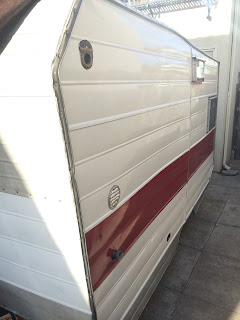I haven't posted in awhile, but it doesn't mean I haven't been busy working on the Aristocrat. Last I wrote I had repacked the bearings, thanks to YouTube and The Wizard at Six Roblees. Next up was to remove the "skin" or aluminum siding to get at the rotted framing. As an aside, I knew she had rot as it was visible on the interior, but even if it is not evident, it is usually there after 50 years, especially in the corners and around windows or skylights. See below...never a good sign when you can see the ground from inside unless you are partial to natural, all weather ventilation and occasional visits by small rodents.



Most people restoring vintage trailers recommend (at the minimum) that new owners remove the J rails and windows and reseal with new butyl putty tape if this hasn't been done on the vintage trailer in some time. Another important fact that most seem to agree on is that it is almost always easier to remove the skin and repair from the exterior, rather than try to repair from the inside out.
So as Spring sprung (and the drought in California continued), I removed the tarp and got to the daunting task of disassembling the trailer, hoping with every step that I would be able to put her back together eventually.
 |
| A worker Selfie removing the Jrails |
Underneath the J rails are the tiny staples (yes, these vintage beauties were actually stapled together!) Most people who have restored an old travel trailer grumble about removing the staples, but I actually found the repetitive, somewhat mindless nature of this job to be satisfying and only occasionally irritating (for those stubborn, rusty suckers that required a few choice words to remove).
Here is a link to a very good tutorial on the subject of removing aluminum skin from a vintage trailer from Gary Williams' videos on Restoring the Deville:
https://www.youtube.com/watch?v=P0av0HtEd98
The tool pictured below is a forked tool for upholstery and tack removal. I found it very helpful to pry under a staple, then use the pliers to ease the staple out the rest of the way. (The beverage and ipod aren't required of course, but recommended!)
Stay tuned for next entry when you will see how she looks "naked"... skin removed.
 |
| Essential tools for staple removal |
|


































